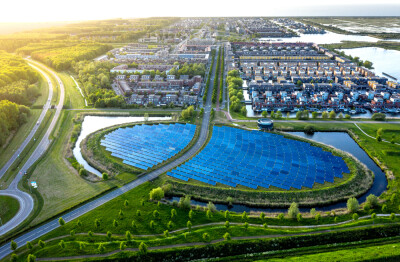In recent years, various industries have started to rely on different technologies to improve upon essential tasks. This is particularly true of the construction sector, which now heavily relies on digital processes and connected machines. A notable way we can build more durable and sustainable buildings is through the use of BIM and digital twins.
BIM and Digital Twins: Definitions
To better understand how the two technologies can work together, you should know how they operate individually.
Building Information Modeling
BIM – or building information modeling – allows users to view and collaborate on a digital 3D model of a given project throughout the project’s duration – from planning to when it’s standing on its own. This model reacts in real-time to any changes made to the project. It can also include supplementary information for individual pieces (for example, the materials, the date of installation, the cost for replacement) that can be queried to get more information, develop maintenance schedules, etc.
The insights gleaned from BIM let engineers, architects, and other relevant stakeholders estimate project cost and duration more easily than they could with a typical CAD or architectural model. Once a building project is complete, the finished BIM is transferred to the client, who can use it for future renovations and repairs.
Digital Twins
A digital twin can provide digital-model representations of objects that exist in the physical world. These virtual representations encompass the entire lifetimes of objects, which are viewed and updated through IoT devices, analytics derived from artificial intelligence (AI), and other technologies. Digital Twins can be updated in near real-time to include data from sensors or other inputs that affect the building’s performance and maintenance.
This approach allows users to align the digital twin with an existing system, which they can use to monitor how the system works in the real world. For example, creating a digital twin of a subway route would allow you to track its activity and environment, and even test adjustments without investing in carrying them out in real life.
How Can BIM and Digital Twins Work Together?
It’s essential to note that BIM and digital twins are different, but they can work together, especially when used to accomplish a common goal.
The best way to think of using them in tandem is that BIM captures the design and construction of a building, whereas digital twins are more focused on how the building is used and operated upon completion. Therefore, using the two when overseeing a construction project can give teams a complete picture of various factors and variables.
Using BIM and Digital Twins for Sustainable Building
One of the most promising uses of BIM and digital twins is for improving sustainability, especially in the construction industry. This field depends on certain harmful environmental practices. As one example, 600 million tons of construction and demolition debris were created in the United States in 2018.
These two technologies can facilitate the necessary changes to reduce construction’s impact on the planet. The capabilities of BIM and digital twins have a far reach, meaning project managers, building operators, residents, and every stakeholder in between can use them to inform more eco-friendly construction projects.
Here are a few ways BIM and digital twins can lessen the carbon footprints of construction projects:
Centralize Building Monitoring
Over the past few decades, many building operators have relied on Internet of Things (IoT) devices to reduce energy consumption. Maybe they installed sensors in bathrooms to turn off the lights when they’re not in use or utilized smart gadgets to monitor the indoor temperature.
While that equipment works, it’s not always easy to see the data it provides, meaning building owners are somewhat left in the dark regarding the reduction of their carbon footprints. That’s because many IoT companies protect the data their devices collect for proprietary reasons.
This information is available in one location, so management and action are simple. There’s no need to monitor each aspect of a building individually, which can lead to disorganization and misinformation, especially when many parties are involved.
Improve Reporting
To truly understand the scope of a building and its environmental impact, building managers can rely on BIM and digital twins. These systems give users access to real-time information about every component of their buildings, even beyond details regarding energy consumption.
Because digital twins give you the complete picture of how a system operates, it’s possible to improve sustainability reporting substantially. Use a digital twin to see reports about waste management, air quality, and other factors that contribute to your carbon footprint reduction efforts.
Streamline Construction Efforts
Through BIM, you can construct a sustainable building from the ground up. Because BIM allows you to track the progress of your construction project from beginning to end, you can make efficient decisions about materials, configurations, and other construction elements that impact the carbon footprint of a project.
Reviewing a project through BIM streamlines a team’s approach to a project. There’s no need to question or assume the decisions everyone is making throughout the duration of a project. Everything is present in the BIM system, meaning everyone’s on the same page when it comes to sustainability.
Make Continuous Adjustments
The beauty of digital twin technology is that stakeholders can use it to continuously improve their buildings even after completion. This approach also comes with little risk. Rather than make permanent changes only to have to fix them later, you can test and visualize improvements via the digital twin to see whether they’re feasible and effective.
Because sustainability is an ongoing process that takes time, the digital twin makes for the perfect tool when you want to achieve carbon-neutral buildings during and after construction. In fact, cities in the U.S. are already piloting digital twin projects to strive toward decarbonization.
These Technologies Are the Future of Construction
Even compared to some other high-polluting industries, construction plays a significant role in the production of carbon emissions worldwide. As a result, the construction projects of the future must take shape with sustainability as a top-of-mind concern. That’s where technology – like BIM and digital twins – can help out.
Whether for residential or commercial buildings, technology can better inform planners, builders, occupants, and maintenance personnel of the best decisions to make to reduce construction’s negative effects on the environment. BIM and digital twins can be crucial tools in the construction and operation of today’s and tomorrow’s buildings, helping us make strides toward a more carbon-neutral future.







